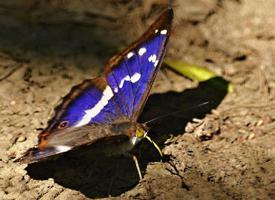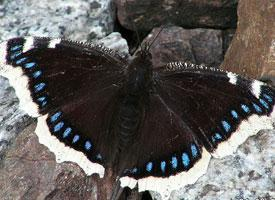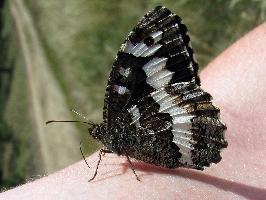
Állatleírás
The Purple Emperor, scientifically known as Apatura iris, is a captivating species of butterfly that belongs to the Nymphalidae family. This species is renowned for its striking appearance and elusive nature, making it a prized sighting among butterfly enthusiasts. The Purple Emperor primarily inhabits the woodlands of Europe and parts of the Asian continent, thriving in areas where its larval food plants, particularly species of willow (Salix) and poplar (Populus), are abundant.Adult Purple Emperors exhibit a notable sexual dimorphism in their wing coloration and patterns. The males are particularly distinguished by their iridescent purple sheen, which is visible only at certain angles due to the microscopic structures on the wing scales that reflect light. This remarkable feature, which gives the butterfly its common name, is absent in females. Instead, females display a more subdued brown coloration with white and orange markings on the wings' edges and tips. Both sexes have intricate eye-spot markings on their wings, thought to deter predators by mimicking the eyes of larger animals.
The wingspan of the Purple Emperor ranges between 70 to 90 millimeters, making it one of the larger butterfly species in its native habitat. The underside of the wings is a cryptic brown with intricate markings, allowing the butterfly to blend seamlessly into its woodland surroundings when at rest.
Purple Emperors lead a largely arboreal life, spending most of their time in the canopy where they feed on tree sap, honeydew produced by aphids, and sometimes on carrion and dung. This preference for high vantage points, combined with their elusive nature, makes the Purple Emperor a challenging species for enthusiasts to observe.
The lifecycle of the Purple Emperor begins with the female laying eggs on the leaves of the host plants. The caterpillars are a striking green with white and yellow markings, providing them with camouflage among the leaves. After several molts, the caterpillar forms a chrysalis, from which the adult butterfly emerges after about two weeks.
Despite their beauty, Purple Emperors face threats from habitat destruction and climate change, which impact their woodland homes and food sources. Conservation efforts are essential to ensure the survival of this species, emphasizing the importance of preserving their natural habitats and understanding their ecological needs.
In conclusion, the Purple Emperor (Apatura iris) is a mesmerizing species that adds to the biodiversity of woodland ecosystems. Its unique characteristics, from the males' iridescent wings to the species' complex lifecycle, make it a fascinating subject for study and conservation. Admirers of this butterfly cherish the rare opportunities to observe it in its natural habitat, a reminder of the wonders that nature holds and the importance of protecting it.
Hasonló állatok
Új állatfotók
Top 10 állat
- Dolphin gull (Leucophaeus scoresbii)
- Japanese macaque (Macaca fuscata)
- Stone loach (Barbatula barbatula)
- Russian tortoise (Testudo horsfieldii)
- Galápagos tortoise (Geochelone nigra complex)
- Greek tortoise (Testudo graeca)
- Diana monkey (Cercopithecus diana)
- Common flying dragon (Draco volans)
- Moustached guenon (Cercopithecus cephus)
- Galápagos penguin (Spheniscus mendiculus)


